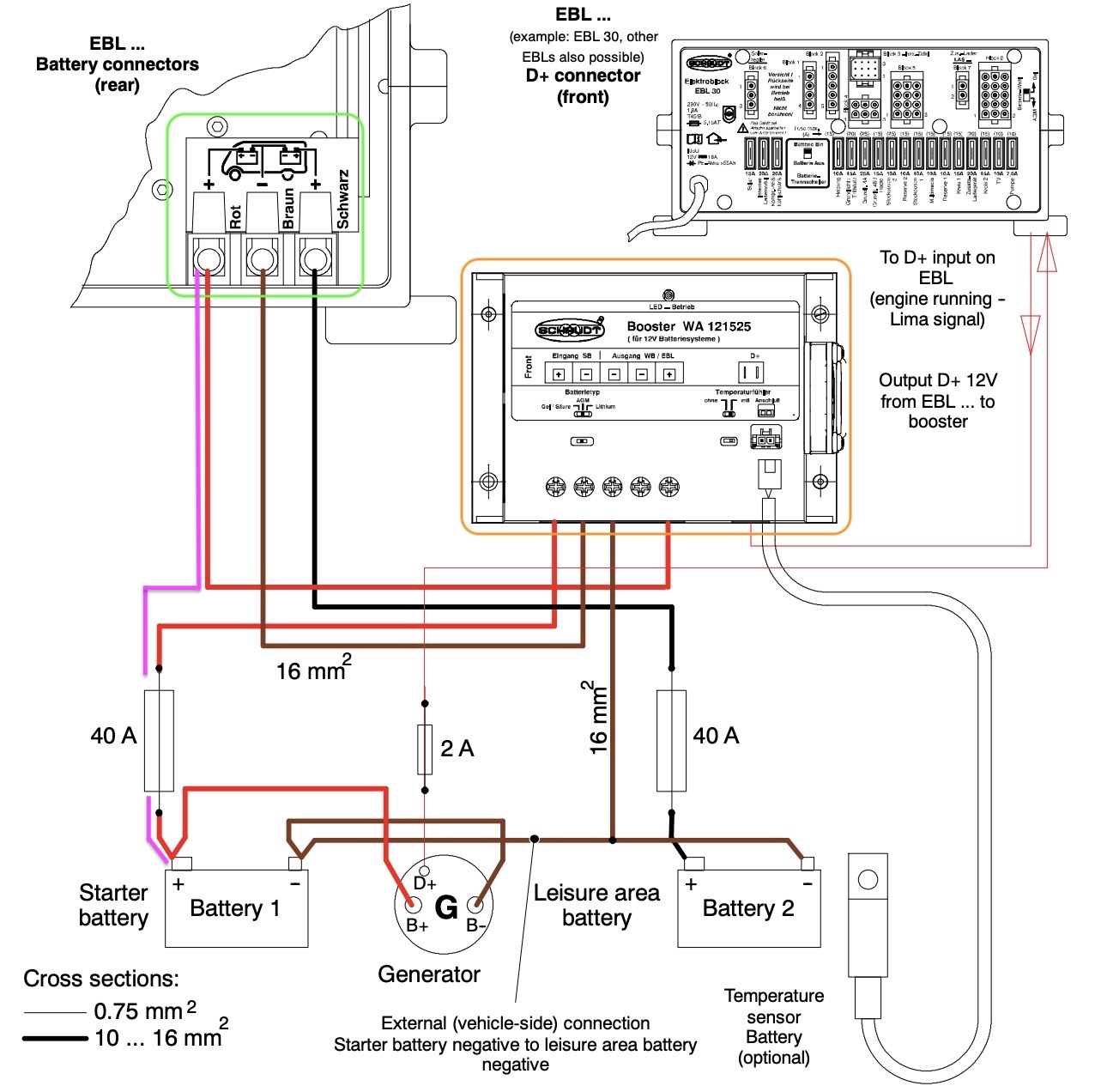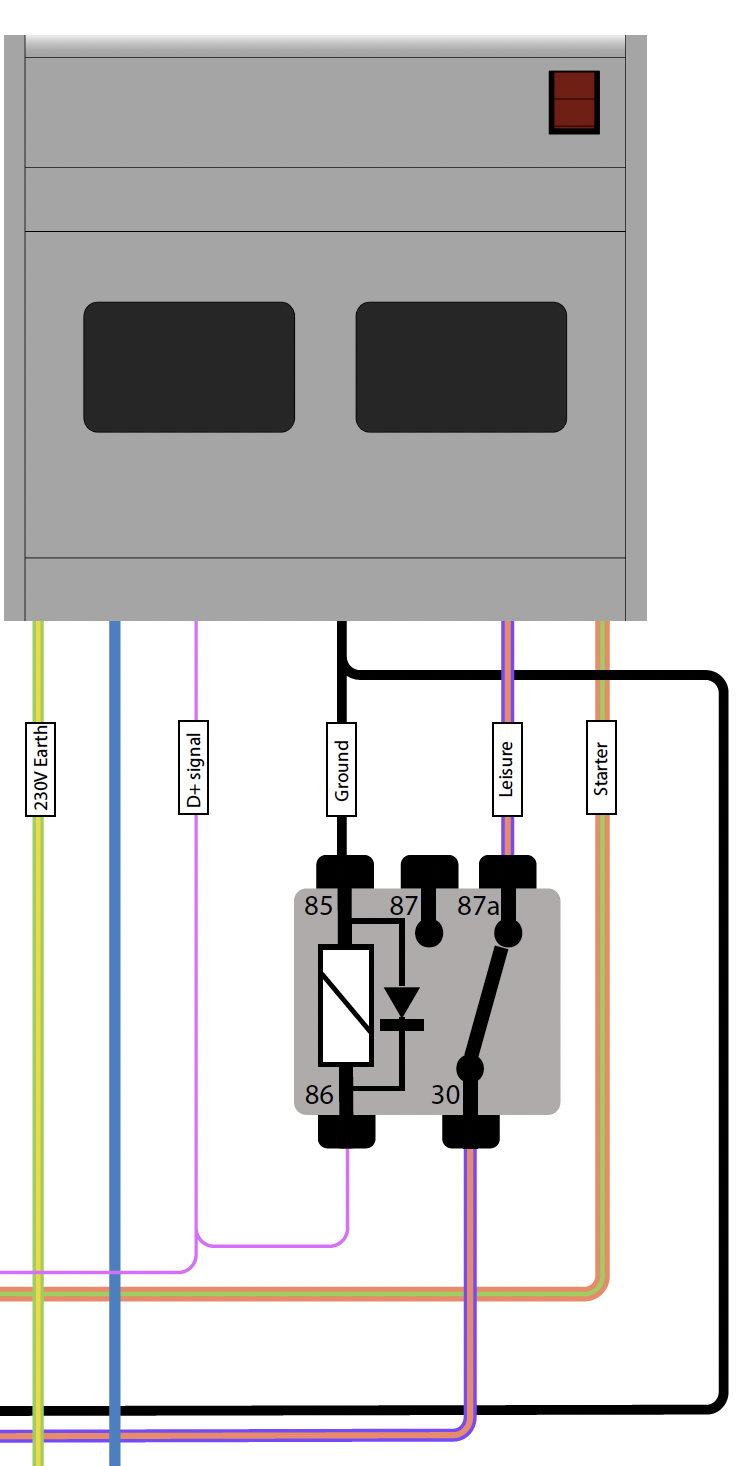Retrofitting a DC-DC charger to a Schaudt/Lippert Elektroblock (EBL) system (EBL-99, EBL-119, EBL-221)
This document serves as a comprehensive guide for those looking to upgrade their existing motorhome systems by fitting a Roamer LiFePO4 lithium battery. The following sections will provide detailed instructions and considerations for integrating a DC-DC charger into your motorhome's electrical system. This guide applies to Schaudt/Lippert Elektroblock (EBL) models such as the EBL-99, EBL-119, EBL-221.
This does not cover the newer EBL227.
The integration of Roamer LiFePO4 lithium batteries into motorhome systems is a frequently requested upgrade. Many motorhome owners seek to enhance their power systems, but may be uncertain about the initial steps. This guide aims to clarify the process and provide useful insights. EBL systems are commonly found in many coachbuilt motorhomes. They offer essential functions; however, due to their tight integration with the vehicle's overall system, it is not advisable to remove them entirely. Maintaining the EBL system while upgrading to a lithium battery is crucial for optimal performance.
Note: The information provided by Roamer is based on available data. Actual electrical installations may differ among various motorhome manufacturers or EBL models. Therefore, we advise against treating this guide as definitive. It is essential to verify and apply sound electrical principles and knowledge in conjunction with the supplementary information provided below.
Fitting a DC-DC Charger up to 30A
This section will outline two methods for fitting a DC-DC charger to EBL units, focusing on the Schaudt/Lippert WA Series "Booster." The principles discussed here apply to all DC-DC chargers. A key consideration is to avoid overloading the original wiring; therefore, it is recommended not to install a DC-DC charger rated over 30A when using the stock wiring - you should run new cables that bypass the EBL unit.
Wiring Example
The wiring diagram may appear complex at first glance, but it can be simplified for better understanding.
In the green box, you will find the battery connections located at the rear of the EBL unit.
The orange box contains the DC-DC Charger, specifically the Lippert WA Series Booster. This diagram is applicable to all DC-DC chargers.
The pink line visually represents the typical wiring of the EBL unit without a DC-DC charger, provided for reference only.
Important Safety Note
DO NOT leave a cable from the starter battery directly connected to the EBL unit.
This is a non-isolated system, meaning all negatives are interconnected at the vehicle's chassis for both the starter and leisure batteries, along with their respective electrical systems. Leaving a cable from starter to the EBL unit would bypass the protections the DC-DC is intended to provide.
Wiring Process
The alternator feed (B+) is directed to the starter battery. From there, we draw the B+ feed from the starter battery terminal, passing it through a 40A fuse, and then into the WA Series Booster at the "Eingang +" (Input +) terminal. The "Ausgang +" (Output +) terminal of the WA Series Booster is then connected to the starter battery input of the EBL module. Ensure the D+ connection from the EBL unit is connected to the new DC-DC charger via its D+, Enable or Remote port.
This method effectively breaks the direct connection from the starter battery to the EBL, allowing the DC-DC charger to be inserted inline. Consequently, the EBL unit remains unmodified, while the voltages supplied to the leisure battery are those from the DC-DC charger, ensuring they are safe and suitable for the lithium leisure battery.
Fitting a DC-DC Charger over 30A
If you wish to install a larger DC-DC charger, it is essential to first verify that your alternator can handle the additional load. It is recommended that the load does not exceed 40% of the alternator's rating, so for example a 150A alternator can handle a DCDC charger up to 60A. You should also ensure that the potential charge current is within the recommended max charge current limit of your leisure battery. For example, we recommend a charge rate up to 25% of the leisure battery capacity to allow for a 4 hour charge (50% or 2 hour charge is the max). So for a 105Ah battery, a 25-30A DCDC charger is ok, a 230Ah battery would be able to comfortably handle up to 60A.
The internal wiring of the EBL system is not rated for currents above 30A, therefore you cannot install a DCDC charger over 30A using the method outlined above. Instead, you should wire the DCDC charger directly between the starter battery and leisure battery, bypassing the EBL unit. Cable sizes and lengths, along with fuse selection can be found in the manual for the DC-DC charger you select.
By running a new cable and bypassing the EBL, you now have two parallel connections and you need to consider the potential to backfeed current while charging. A high current changeover relay should be fitted to ensure that the either the leisure battery or the starter battery is disconnected from the EBL unit when the engine is running. Which you choose to isolate will depend on your circumstances. So for example, if you choose to isolate the starter battery then all loads being powered by the EBL (eg the fridge) will then use the DCDC charge current first. This will reduce the charge current going into the battery. Isolating the leisure battery instead will prevent this problem and allow you to maximise the charge current, however will place additional load on the alternator (because it is now powering the full DCDC charge current PLUS the fridge).
Example shows one method of wiring up a changeover relay and generic power distribution unit, to allow for isolation of the leisure battery while engine is running.
The relay should reconnect the EBL when the engine is off. You should therefore ensure you choose the correct type of relay - we recommend a 30A/40A changeover relay with diode protection to match the EBL max current. You can use a higher rated model if you prefer (Durite make a 70A maxi changeover relay) but it will not fit in a standard relay socket/box.


